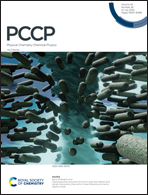Synergistic influence of FRET, bulk recombination centers, and charge separation in enhancing the visible-light-driven photocatalytic activity of Cu2+-ion-doped ZnO nanoflowers†
Abstract
Pure ZnO and a group of Cu2+-ion-doped (4, 6, and 8 wt%) ZnO nanomaterials are synthesized using the co-precipitation technique. X-ray diffraction and Fourier transform infrared spectroscopy confirm both the substitution of Zn2+ ions by Cu2+ ions in the ZnO lattice and formation of the ZnO/CuO composite. The divalent oxidation state of Cu is confirmed using X-ray photoelectron spectroscopy. A suppression in the oxygen vacancy density is observed up to a doping level of 6 wt%, but beyond that it increases. Scanning electron microscopy (SEM) and transmission electron microscopy (TEM) show a cross-linked nanoflower-like structure. The presence of a separate CuO phase is also confirmed via TEM. Absorption spectroscopy yields a reduction in the bandgap up to 6 wt%, after which it is increased for 8 wt%. An enhanced plasmon band in the spectra reveals the presence of CuO. The photoluminescence is quenched for doping up to 6 wt%, and with further doping the emission is enhanced. These observations are explained by the doping-concentration-dependent Förster resonance energy transfer (FRET) phenomenon between the ZnO (donor) and the CuO (acceptor). For the highest doping concentration, the emission profile shows a sudden enhancement resulting from the simultaneous competition of two FRET mechanisms (the intra-acceptor mechanism and the inter-donor–acceptor mechanism). By contrast, for other doped nanomaterials, the inter-donor–acceptor FRET mechanism with doping-concentration dependence is able to explain the suppression of the emission intensity. All doped nanomaterials show an improved visible-light-driven photocatalytic efficiency compared with pure ZnO for methylene blue, which results from the synergistic effects of a reduction in the concentration of bulk defects, enhanced charge separation, and FRET. The highest photocatalytic performance is demonstrated by the 6 wt% nanomaterial due to its optimum doping concentration. However, beyond this concentration, the formation of excessive CuO on the surface of ZnO increases the concentration of bulk defects, and the simultaneous occurrence of the inter-donor–acceptor FRET and intra-acceptor FRET mechanisms takes place leading to the rapid recombination of electron–hole pairs and reduced photocatalytic activity.



 Please wait while we load your content...
Please wait while we load your content...